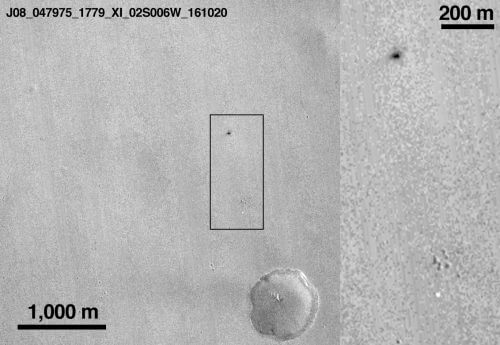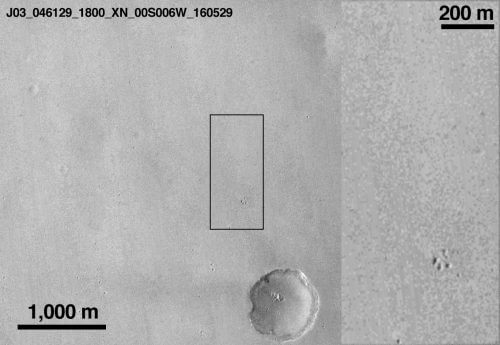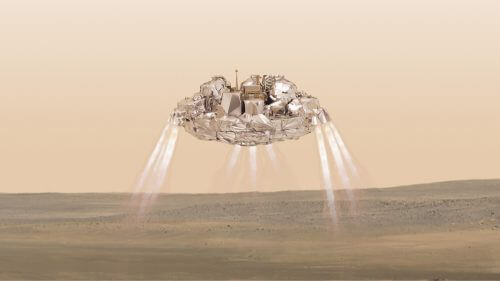In the photos taken by the American MRO spacecraft, a bright formation is visible in the width of the lander's chute (12 m) as well as a dark spot 40 meters long and about 15 meters wide - the impact crater of the lander.


In the image taken by NASA's MRO spacecraft you can see Schiaparelli's parachute (bright spot at the bottom of the image) and the impact site of the spacecraft on the Martian soil (dark spot at the top).
The Mars lander Schiaparelli that stopped communicating with the European Space Agency's control center about a minute before its scheduled landing on Wednesday, October 19, has been discovered. In the images of the landing site taken by the American Mars Reconnaissance Orbiter, the confirmation came to the suspicions of the members of the Exo Mars team - that Scipriali died a violent death.
The photos show a bright formation the width of the lander's parachute (12 m) as well as a dark spot 40 meters long and about 15 meters wide - the impact crater of the lander.
"The estimates are that Schiaparelli fell from a height of between 2 and 4 km and therefore reached the ground at a high speed - more than 300 km/h," the European Space Agency wrote.
"The relatively large size of the formation is due to a disturbance that took place on the surface" added the agency personnel. "It is also possible that the lander exploded at the moment of impact, since it was likely that its maneuvering fuel tanks were still full."

Members of the ExoMars team and think tanks on behalf of the European Space Agency say that the fuel tanks were still full because the lander did not activate its deceleration thrusters for the planned time - about 30 seconds but only about 4-5 seconds.
MRO took the images with the CTX camera which is one of its low resolution cameras. High-resolution images from MRO's HiRISE instrument will be taken next week, the European Space Agency has promised.
The spot is about 5.4 km west of Schiaparelli's intended landing site on the meridian plane - a high plateau slightly south of the planet's equator, the impact area is within the planned landing ellipse that is 100 by 15 kilometers long.
Schiaparelli launched in March of this year together with the TGO project - the residual gas project. The two spacecraft form the first part of a two-phase program called ExoMars, which is led by the European Space Agency with Russia's federal space agency, Roscosmos, as the main partner.
Schiaparelli's main mission was to help demonstrate the technologies needed to land a rover - the second phase of the Exo Mars mission safely in 2021. According to ESA officials, the spacecraft's entry into the atmosphere and its descent will benefit the plan, even if the spacecraft did not stick to the entire landing procedure.
